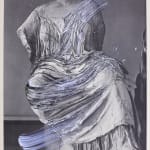

Ann-Marie James
Classical Greece, Frontispiece: Leto, 2017
Ink on paper
37 x 29.5 cm (43 x 35.5 cm)
Copyright The Artist
'Leto (or Hestia) Eastern pediment This proud, majestic figure is on the right hand side of the eastern pediment of the Parthenon, immediately next to Aphrodite and Dione. It has...
"Leto (or Hestia)
Eastern pediment
This proud, majestic figure is on the right hand side of the eastern pediment of the Parthenon, immediately next to Aphrodite and Dione. It has been identified as Hestia, goddess of the hearth, but is more likely to be Leto, the mother of Artemis and Apollo. Her tunic is draped in long, graceful folds which cover her feet. She seems to be leaning toward the central figures of Zeus and the newly emerged Athene, as if to hear of the goddess's birth."
Eastern pediment
This proud, majestic figure is on the right hand side of the eastern pediment of the Parthenon, immediately next to Aphrodite and Dione. It has been identified as Hestia, goddess of the hearth, but is more likely to be Leto, the mother of Artemis and Apollo. Her tunic is draped in long, graceful folds which cover her feet. She seems to be leaning toward the central figures of Zeus and the newly emerged Athene, as if to hear of the goddess's birth."








